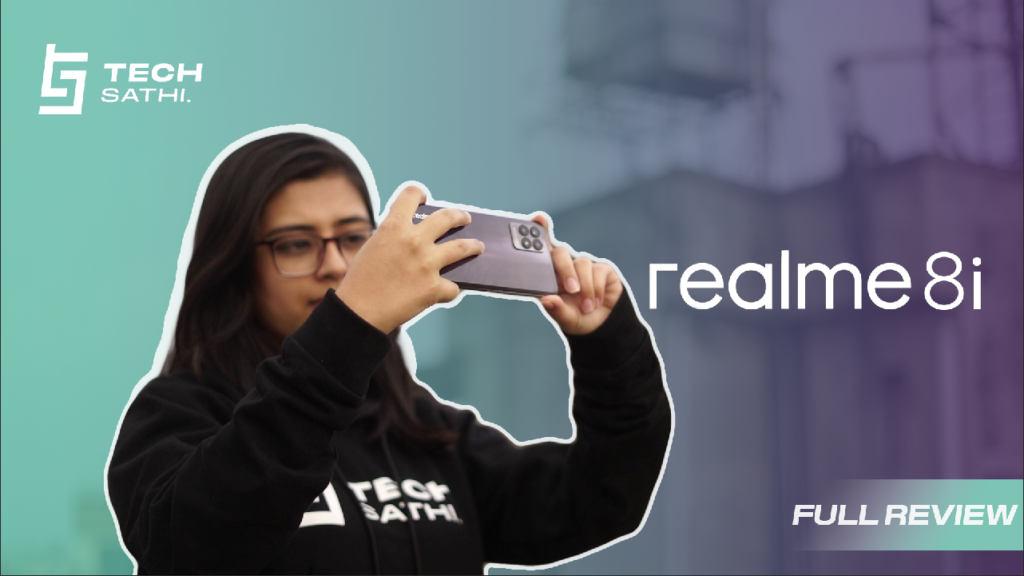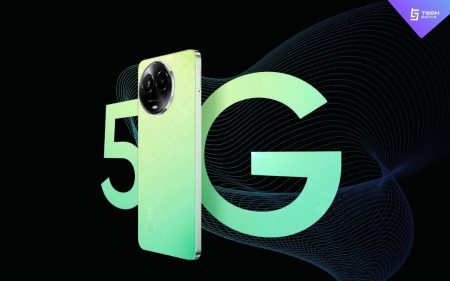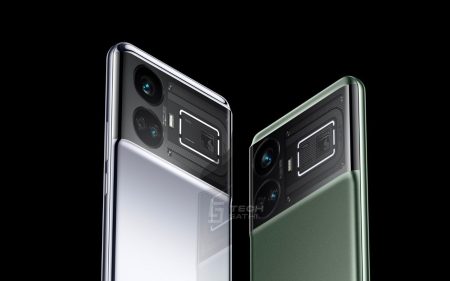Realme introduced their new mid-range device Realme 8i in the Nepalese smartphone market. Realme 8i is the successor of the Realme 7i. Compared to Realme 8, it is a more affordable option. This new smartphone’s headlining features are its 120Hz ultra-smooth display, MediaTek Helio G96 SoC, 50MP AI Triple Camera, Up to 5GB Virtual RAM, and 5,000mAh battery. Adding to this, the pricing of Realme 8i is more fascinating i.e. NPR. 23,799 for 4+64GB variants, which list this device in one of the most competitive segments in the market. Can the Realme 8i be a new value-for-money device? Can it really outshine the competition, or should you consider other options? To find answers to these questions, I have been testing out the device for a week. And here is my verdict regarding the device.
realme 8i Full Review: Navigation
Unboxing of the Realme 8i
The Realme 8i phone arrives in an eye-catchy yellow box. Inside the box, you can find an 18W power adapter and a USB Type-C cable. Also, in the paper compartment – you can find a soft transparent case.
Design
Realme devices are always appreciated for making good-looking phones on a budget, and giving continuation to their trend – the Realme 8i is yet another good-looking device for you. Realme 8i comes with two-color variants. They are:
- Space Black
- Space Purple
Currently, for the review, we have been using a Space Black version and it looks very appealing to the eyes. The body of the Realme 8i is made of plastic and the rear panel has an “arc beam” texture that pops when light falls on it. The Realme 8i is mostly glossy, which makes it a giant fingerprint magnet, and you would probably want to clean it occasionally. The camera module is in the upper left corner and protrudes slightly. At the first glance, it feels like it has a quad-camera setup but this phone only has three cameras.
The Realme 8i flaunts a flat front/curved back design, with a cool gradient paint job that spreads across the frame as well. Realme 8i has a bigger display with a punch-hole camera in the top-left corner. The borders are thin at the sides but comparatively thicker at the top and the bottom. On the right-hand side, there’s a fingerprint scanner mounted on the power button, while the volume rockers are on the left. For me, I find these buttons placed perfectly. As I can reach them without a stretch. The left of the frame also has the tri-card tray where the card tray accommodates two nano-SIMs and a microSD card. The bottom portion of the phone is crowded with the 3.5mm jack, the mouthpiece, the USB-C port, and the speaker grille, while there is nothing on the top.
The Realme 8i feels light in hand even though it comes with a massive 5000 mAh battery.
Display
The main aspect to pursue Realme 8i is its display. Considering the budget price of the Realme 8i, this has to be one of the most affordable 120Hz to date. The Realme 8i features a 6.6-inch IPS LCD screen of 1,080 x 2,412 pixels. It supports a dynamic 120Hz refresh rate and can switch between 30Hz, 48Hz, 50Hz, 60Hz, 90Hz, and 120Hz on the go. The touch sensors work with a 180Hz sampling rate. However, there is no HDR support.
The phone feels brighter while using it indoors. Also, you have no issue while using the phone outdoors or under direct sunlight. Adding to this, either you can manually adjust the brightness or set it in auto mode. As per the paper, the Realme 8i can achieve a peak brightness of 600 nits.
Performance
Realme 8i is equipped with Mediatek Helio G96 (12 nm) chipset. We perform some standard benchmarks test on the Realme 8i to see how it stands against the competition. In AnTuTu, the Realme 8i scored 337,297 points, whereas in Geekbench 5’s single-core and multi-core tests it managed 538 and 1,714 points respectively.
From the benchmark tests we’ve done, it is evident that the Realme 8i is not a powerhouse. But the scores don’t suggest the Realme 8i is an incapable phone, not at all. And our real-life impressions confirm this – we’ve played plenty of games with good 3D graphics and a smooth frame rate stutter-free. The Android and Realme UI run great at 120fps, multi-tasking is good, and demanding office apps. Overall, we’ve never felt the Realme 8i lacking in performance, and we are happy with its experience.
Finally, the Realme 8i is available in two configurations, both with LPDDR4X RAM and UFS 2.1 storage – 4GB RAM + 64GB and 6GB RAM + 128GB.
Camera
Even though the camera at back looks like a quad-camera setup but it has only three snappers on its back. The primary camera is a 50MP with a wide-angle lens which is followed by a 2MP macro shooter, and a 2MP monochrome depth sensor. For selfies, there is a 16MP selfie camera.
The phone clicks appealing selfies. While the selfies appear a tad beautified even after disabling all of the beautification features, the end result isn’t all that bad. What’s more, the portrait selfies have a clean bokeh cutout too, which is great.
Images clicked from the rare camera are not that outstanding. But, compared to the price that we are paying for this device, the image quality is not that bad at all. Images captured from the 50MP primary camera look good and detailed in a well-lit environment. Adding to this, this phone can shoot 2x and 5x zoomed images as well. And, the images that are shot in portrait mode look decent.
Battery
The Realme 8 is powered by a large 5,000 mAh battery that supports 18W charging. And the battery life on the Realme 8i was good. This phone could last me about 2 days with my usage. Realme supplies an 18W charger in the box, which is capable of charging the battery to 30 percent in 30 minutes and 56 percent in an hour. Following this, a full charge takes 2 hours and 21 minutes.
Software
The Realme 8i ships with Realme UI v2.0 on top of Android 11. Unsurprisingly, the interface ships with a ton of bloatware, so you’ll have to take out the time and uninstall irrelevant apps when you first set up the phone. Thankfully, unlike some custom skins, RealmeUI allows buyers to thoroughly customize their home screens by installing third-party icon packs, etc. You’ll also get some other niceties with the interface, including built-in call and screen recording utilities, the screen on and off gestures.
Specifications
| DIMENSIONS & WEIGHT | 164.1 x 75.5 x 8.5 mm (6.46 x 2.97 x 0.33 in) 194 g (6.42 oz) |
| DISPLAY | 6.6-inches, IPS LCD, 120Hz, 600 nits (peak) 1080 x 2412 pixels 400 PPI 20:9 Aspect ratio |
| SoC | Mediatek Helio G96 (12 nm) |
| Chipset | Octa-core (2×2.05 GHz Cortex-A76 & 6×2.0 GHz Cortex-A55) Mali-G57 MC2 |
| Rear Camera | 50 MP, f/1.8, 26mm (wide), PDAF 2 MP, f/2.4, (macro) 2 MP, f/2.4, (depth) LED flash, HDR, panorama 1080p@30fps |
| Front Camera | 16 MP, f/2.1, (wide) Panorama 1080p@30fps |
| RAM | 4 GB/ 6 GB |
| Storage | 64 GB / 128 GB expandable up to 256 GB |
| Operating System | Realme UI 2.0 (Based on Android 11) |
| Sensors | Fingerprint (side-mounted), accelerometer, gyro, proximity, compass |
| Other Features | Wi-Fi 802.11 a/b/g/n/ac, dual-band, hotspot Bluetooth 5.1 USB Type-C 2.0 |
Pros and Cons
| Pros | Cons |
| 120Hz display | Lots of bloatware |
| Good battery life | Camera |
| Eye-catching design | |
| Pricing |





